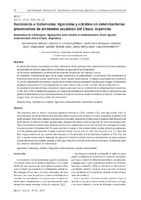Resistencia a fosfomicina, tigeciclina y colistina en enterobacterias provenientes de ambientes acuáticos del Chaco, Argentina
Resistance to fosfomycin, tigecycline and colistin in enterobacteria from aquatic environments from Chaco, Argentina
Date
2020-11-27Author
Balcaza, José Alexander
Kurz, Ingrid
Macin, Cristela Itatí
Mosquera, María Silena
Sandi, Alejandro
López, Diego
Leyes, Salvador Rolando
Lösch, Liliana Silvina
Merino, Luis Antonio
Metadata
Show full item recordAbstract
El objetivo fue detectar la resistencia frente a fosfomicina (FOS), colistina (COL) y tigeciclina (TGC) en enterobacterias recuperadas de fuentes superficiales y profundas de agua del Chaco (Argentina). Se incluyeron aislamientos provenientes de muestras de agua de ríos, lagunas y pozos. Se analizaron 70 muestras de agua (40 de origen superficial y 30 subterráneas). Se obtuvieron 106 aislamientos de enterobacterias (68 en fuentes superficiales y 38 en fuentes subterráneas). En aguas superficiales se encontraron 10 (14,7%) aislamientos resistentes a alguno de los antimicrobianos estudiados mientras que en aguas subterráneas resultaron resistentes 3 (7,9%) aislamientos; en total: FOS (8), TGC (1), COL (1), FOS+TGC (2) y FOS+COL (1). El presente es el primer trabajo realizado en nuestro país cuyo foco es la detección de enterobacterias resistentes a FOS, COL y TGC en ambientes acuáticos. El número de aislamientos resistentes encontrados es bajo pero su sola presencia debe alertar sobre el posible pasaje de este tipo de bacterias desde el ambiente al hombre, considerando al agua como un reservorio y medio de transmisión. The objective was to detect resistance against fosfomycin (FOS), colistin (COL) and tigecycline (TGC) in enterobacteria recovered from surface and deep water sources in the province of Chaco (Argentina). Isolations from water samples from rivers, lagoons and wells were included. Resistance profiles were studied by disk diffusion and broth dilution. A total of 70 water samples were analyzed (40 from a surface origin and 30 from the underground). 106 enterobacteria isolates were obtained (68 from the superficial sources and 38 from the underground ones). In surface waters 10 isolates (14.7%) were resistant to some of the antimicrobials studied while in groundwater, 3 (7.9%) isolates were resistant. It made a total of FOS (8), TGC (1), COL (1), FOS+TGC (2) y FOS+COL (1). This is the first study carried out in our country that focusses on the detection of enterobacteria resistant to FOS, COL and TGC in aquatic environments. Although the amount of resistant isolation found is relatively low, its mere presence should alert about the possible passage of this type of bacteria from the environment to humans, considering water as a reservoir and means of transmission.
URI
https://hdl.handle.net/20.500.12219/2859https://doi.org/10.36995/j.recyt.2020.34.013
https://www.fceqyn.unam.edu.ar/recyt/index.php/recyt/article/view/553
Collections
The following license files are associated with this item:




